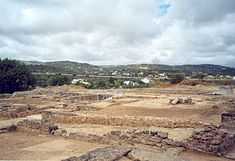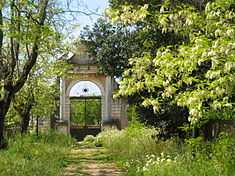Estoi
| Estoi (Estói) | |
| Civil parish (Freguesia) | |
 A view of the ruins of Milreu, with the landscape of the parish of Estoi | |
| Official name: Freguesia de Estoi | |
| Country | |
|---|---|
| Region | Algarve |
| Subregion | Algarve |
| District | Faro |
| Municipality | Faro |
| Center | Estoi |
| - coordinates | 37°06′N 7°54′W / 37.100°N 7.900°W |
| Highest point | |
| - location | Estoi |
| Lowest point | Sea level |
| - location | Atlantic Ocean, Estoi |
| - elevation | 0 m (0 ft) |
| LAU | Freguesia/Junta Freguesia |
| - location | Largo Ossónoba, Estoi, Faro |
| Timezone | WET (UTC0) |
| - summer (DST) | WEST (UTC+1) |
| ISO 3166-2 code | PT- |
| Postal zone | 8005-454 Estoi |
| Area code & prefix | (+351) 289 XX XX XX |
| Parish address | Largo Ossónoba, 71 8005-454 Estoi |
| Wikimedia Commons: Estoi | |
| Statistics: Instituto Nacional de Estatística[1] | |
| Geographic detail from CAOP (2010)[2] produced by Instituto Geográfico Português (IGP) | |
Estoi (Portuguese pronunciation: [(ɨ)ˈʃtoi]) is a civil parish in Portuguese municipality of Faro, in the Algarve. The parish which includes an area of approximately 46.55 square kilometres (17.97 sq mi), supporting a population of 3538 inhabitants (as of 2001 census records). The name of the parish, which was formerly spelled "Estói", was changed in 2004.
Geography
Estoi is a village and parish in the municipality of Faro, a rural zone that extends from the fertile fields of Campina de Faro, until the peaks of Serra do Monte Figo (Cerros de São Miguel, Azinheiro, Malhão, Bemposta, Monteiro and Guelhim), that have been, since antiquity, beacons for navigation and natural outlooks along the coast of the Algarvian Riviera.
Architecture


The Palace of Estoi is a rococo building renowned for its gardens and azulejos (blue and white tiled ceramic). The palace was built in the late 19th century and is the finest example of this kind of architecture in the district of Faro.[3]
The ruins of Milreu, in the vicinity of Estoi, show that area was already populated in Roman times. The excavations brought to light an extensive Roman villa with adjacent buildings.[4]
References
- Notes
- ↑ INE, ed. (2010), Censos 2011 - Resultadas Preliminares [2011 Census - Preliminary Results] (in Portuguese), Lisbon, Portugal: Instituto Nacional de Estatística, retrieved 1 January 2012
- ↑ IGP, ed. (2010), Carta Administrativa Oficial de Portugal (in Portuguese), Lisbon, Portugal: Instituto Geográfico Português, retrieved 1 July 2011
- ↑ José Carlos Vilhena Mesquita, O Palácio de Estoi. Subsídios para a sua história. Faro. 1982.
- ↑ Hauschild, Theodor (2002), Milreu. Ruinen (in German), Lisbon, Portugal: Kultusministerium
- Sources
- Oliveira, Ataíde (1993), Monografia de Estói (in Portuguese), Faro (Algarve), Portugal: Algarve em Foco
- Teichner, Felix (1994), "Acerca da vila romana de Milreu/Estói. Continuidade da ocupação na época árabe", Arqueologia medieval (in Portguese) (3), Lisbon, Portugal, pp. 89–100
External links
| Wikimedia Commons has media related to Estoi. |
 Media related to Palácio de Estói at Wikimedia Commons
Media related to Palácio de Estói at Wikimedia Commons
| |||||||